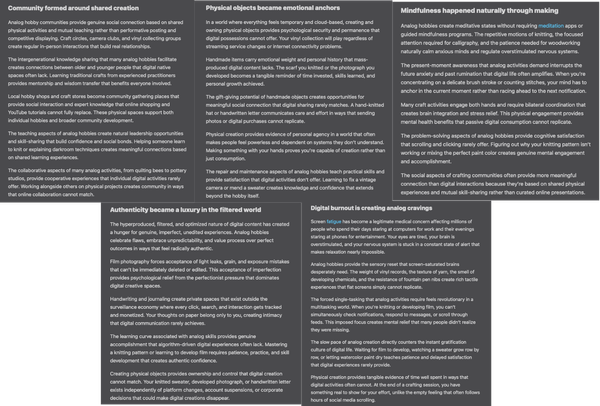Something for World Mental Health Day
On finding a therapist

📝 Notes from Jenn:
❓Source request: Still looking to talk to some coffee people who had temporary or permanent sensory loss after getting COVID. I’ve also found that some people may not feel comfortable sharing publicly, so anonymity is possible.
🔏 Last week, paid subscribers received an essay on my tendency to use things until they stop working and far past when I should’ve replaced them.
🍩 What I ate/drank/snacked on: Um—I found kiwi berries at my local grocery store. Yes, mini kiwis! The skin was smooth and had no taste, while the fruit itself tasted just like the bigger version!


Something for World Mental Health Day (Oct. 10)
I didn’t know what to write about today. I was 280 words deep on an essay topic that felt a tad too trivial, so now I’m writing about a topic that is important to me and timely.
I learned yesterday that one in four US children live with at least one foreign-born parent (as of 2019). By race, the US mental health professional demographic skews heavily towards white. While foreign-born does not necessarily mean not white, it would be safe to say that this set does not entirely reflect the current population. Below is a graphic pulled from the 2021 National Healthcare Quality and Disparities Report.

I can only speak to the difficulties of finding a therapist in the US. The healthcare system here is fucked up in many different ways, and mental health is already stigmatized and an afterthought. When you’re in the midst of a crisis, it’s a terrible time to find care. The system is backed up on patients, and therapists are booked months in advance. Paying for this is usually out of pocket, because insurance doesn’t play well with many therapists. But once you find one that fits your particular issues, you still have to go through the screening call and the hour-long intro session where you try to tell them everything succinctly. It usually takes several sessions (paid) to know if they’re a good fit. Rinse and repeat if they’re not.
I’ve written about my therapy experience elsewhere. My first two therapists were white women. The first one fell asleep multiple times in our in-person sessions. I should’ve fired her earlier than I did. Later, I found her featured on a list of “safe therapists,” but holding a safe space doesn’t negate poor job performance. The second one told me I didn’t have anxiety because it needed to be debilitating in my everyday life for it to be diagnosed. I fired her, too. Because as it turns out, it was debilitating, but I’d been dealing with it for so long that I thought it was all common behavior when it was not.
To both of them, I discussed my experiences with racism and sexism and found myself explaining things to them. Like explaining why something was racist, why an event rattled me so much, and what it felt like when micro-aggressions piled up. I would sometimes bring up my family and then be met with a suggestion of, “Why don’t you just tell them about this boundary,” as if it were that straightforward.
My following two therapists were Asian women. I hadn’t realized how much I needed to have someone of my culture reflected back to me. They’re not exactly me, but I did not have to explain anything cultural to them. When I said I was nervous about a visit to Taiwan, they understood why. When I told them about the expectations set on me as a child, they knew what I meant. I never had to explain the complexities of growing up as a child of immigrants and straddling cultures or never quite fitting in anywhere. I didn’t have to explain guilt or why something rattled me. Or the duality of growing up in a Western, individualist society but living in an Eastern, community-oriented culture at home. I didn’t have to say why I felt an intense fear of walking to the grocery store, when I had learned recently of two anti-Asian attacks near where I lived.
Another way of putting this would be—if you were Very Online and someone doxxed you or made a public post that had a bullying nature, if you weren’t on those platforms, you wouldn’t understand the complexities of internet culture or the gravity of certain things. You could try and explain and hope they’re sympathetic, but for some things, you can’t study your way to expertise. There’s no substitute for lived experiences.
I now encourage people looking for therapists to find someone who reflects their core being, especially if it intersects directly with the issues you want to discuss. ALSO, talk therapy is not some magical pill. It doesn’t work for everyone and is not the only way to manage your mental health. If you need advice or help looking for therapists or managing medication, I’m always happy to share my experiences (you can just reply to this email).

👀 interesting reads
- This City Wants to Eliminate Food Deserts With a Municipally-Owned Grocery Store [More Perfect Union]:
Like many U.S. cities, Chicago has struggled with food deserts. In the Southside’s Riverdale neighborhood, for example, nearly every single resident — 99.85 percent, to be exact — lives more than a half-mile from the nearest grocery store, according to the Chicago Health Atlas.
One potential disconnect between the two concepts is that feeling included and being included are not one and the same. Just because you feel like you belong doesn’t mean that you are actually accepted by others. Conversely, feeling like you don’t belong doesn’t necessarily mean that other people don’t accept and respect you.
- It's not just you. LinkedIn has gotten really weird. [Business Insider]: I find this generational shift so fascinating. What some term as “unprofessional” or “oversharing,” others say it’s normal.
There's also a generational shift, with some younger people having fewer hang-ups sharing with their colleagues. Oversharing comes "pretty much down to Gen Z, to be honest with you," said Catalina Valentino, a 21-year-old entrepreneur.
- It’s Never Just a Milkshake [Eater]: I did not grow up drinking milkshakes, nor did I have much nostalgia tied to diners. BUT, I—in all my lactose-intolerant glory—LOVE a good milkshake. In Chicago, I fell in love with them at Eleven City Diner, and now, I live by two diners with milkshakes.
Though fast food would go on to saturate every market and demographic, the meal it originally served was nostalgia for a select few. Under the sweetness and the froth, the milkshake represents America not as it was but as certain people wanted it to be. Wholesome, innocent, white.






